| Home > Think Tank > German WWII > Flak – from a modeller's viewpoint (part II of II) |
|
||||||||||||||||||||||||||||||||||||||||||||||||||||||||||||||||||||||||||||||||||||||||||||||||||||
| Gun feed by | Weight of round/ mag. | Ammunition storage* | |
| 2cm Flak 28 (Oerlikon) | 15 round magazine | 6.3kg | Airtight amm. Box. 130 cartridges 49kg |
| 2cm Flak 30 2cm Flak 38 2cm Geb. Flak 38 2cm Flak Vierling 38 |
20 round magazine | 9.5kg | Airtight amm. Box. |
| 3.7cm Flak 18 3.7cm Flak 36/37 |
6 round clip Single shot – (Stiel-Gr. 41) |
12.5kg 8.60kg |
Airtight amm. Box. 18 12 cartridges 25 kg - Airtight amm. Box. 16 cartridges 31 kg - Airtight amm. Con. 1 grenade 10.4kg |
| 3.7cm Flak 43 | 8 round clip | 16.5kg | Airtight amm. Box. 16 cartridges 31kg |
| 4cm Flak 28 | 4 round clip | 2.10kg | Amm. Box 8 cartridges 22kg - 20 cartridges 61kg |
| 5cm Flak 41 | 5 round clip | 30kg | Airtight amm. Box. 41 3 cartridges 19kg |
| 8.8cm Flak 18/36/37 | Single shot | HE 14.7kg AP 15.3kg |
Amm. wicker basket 3 cartridges 56kg - Amm. Box 3 cartridges 60kg - Airtight amm. Con. 1 cartridge 20kg |
| 8.8cm Flak 41 | Single shot | HE 19.2kg AP 19.8kg |
Airtight amm. Con. 1 cartridge 25kg - Amm. box 2 cartridges 50kg |
| 10.5cm Flak 38/39 | Single shot | HE 26kg AP 26.1kg |
Amm. Con. 38 1 cartridge 32kg - Amm. box 2 cartridges 62kg |
| 12.8cm Flak 40 | Single shot | HE 47.7kg AP 46.5kg |
Amm. Box 40 1 cartridge 72kg |
* New ammunition boxes (factory fresh).
Abbreviations/ explanations:
1. Airtight = The wooden box had an airtight sheet metal lining.
2. Amm. = Ammunition.
3. AP = Armour piercing.
4. Con. = Container (tube container).
5. Geb. = Gebirge (Mountain (Gun for mountain troops)).
6. Gr. = Granate (grenade)
7. HE = High Explosive
8. kg = Kilogram
9. Mag. = Magazine
10. Stiel = (stick)
| Samples of text on
ammunition boxes and containers |
||
| Ammunition | Boxes and containers | |
| 2cm Flak 28 | 2cm Sprgr. Patr. L/Spur 2cm Pzgr. Patr. 2cm Pl. Patr. |
Luftdichter Patronenkasten 18. |
| 2cm Flak 30 2cm Flak 38 2cm Geb. Flak 38 2cm Flak Vierling 38 |
2cm Sprgr. Patr. L/Spur 2cm Sprgr. Patr. Đb. 2cm Br. Sprgr. Patr. vk L/Spur W. 2cm Br. Sprgr. Patr. L/Spur 2cm Pzgr. Patr. 2cm Pzgr. Patr. L/Spur |
Luftdichter Patronenkasten. HEERES Munition1 Gesamtgewkg |
| 3.7cm Flak 18 3.7cm Flak 36/37 |
3.7cm Sprgr. Patr. 18 3.7cm Br. Sprgr. Patr. L/Spur 3.7cm Pzgr. Patr. 18 3.7cm H. Pzgr. Patr. L/Spur o. Zerl. 3.7cm H. Pzgr. Patr. L/Spur m. Zerl. 3.7cm Stielgranate 412 |
Luftdichter Patronenkasten 18. Luftdichter Patronenkasten d. 3.7cm Flak 18. Mun. 3.7 Flak (Stiel-Gr.) |
| 3.7cm Flak 43 | 3.7cm Sprgr. Patr. 18 3.7cm Br. Sprgr. Patr. L/Spur 3.7cm Pzgr. Patr. 18 3.7cm H. Pzgr. Patr. L/Spur o. Zerl. |
Luftdichter Patronenkasten 18. Luftdichter Patronenkasten d. 3.7cm Flak 18. |
| 4cm Flak 28 | 4cm Sprgr. Patr. L/Spur 4cm Br. Sprgr. Patr. L/Spur |
Patronenkasten 4cm Flak 28. |
| 5cm Flak 41 | 5cm Sprgr. Patr. 41 L/Spur 5cm Br. Sprgr. Patr. 41 L/Spur 5cm Pzgr. Patr. 42 |
Luftdichter Patronenkasten 41 d. 5cm Flak 41. |
| 8.8cm Flak 18/36/37 | 8.8cm Sprgr. Patr. L/4,5 8.8cm Pzgr. Patr. 8.8cm Pzgr. Patr. 39 8.8cm Hl.G. Patr. 39 Flak 8.8cm Pzgr. Patr. 40 8.8cm Leucht-geschoss L/4,4 |
Patronenkasten 8.8cm Flak 18. Luftdichter Patronenbeh”lter 8.8cm Flak 18. |
| 8.8cm Flak 41 | 8.8cm Sprgr. Patr. Flak 41 8.8cm Sprgr. Patr. Flak 41 Gerillt 8.8cm Pzgr. Patr. 39 Flak 41 8.8cm Pzgr. Patr. 40 Flak 41 |
Patronenkastend.
8.8cm Flak 41. Luftdichter Patronenbeh”lter 8.8cm Flak 41. |
| 10.5cm Flak 38/39 | 10.5cm Sprgr. Patr. L/4,4 10.5cm Sprgr. L/4.4 Gerillt 10.5cm Pzgr. Patr. Flak 10.5cm Pz. Sprgr. Patr. Flak |
Patronenkastend.
10.5cm Flak 38. Luftdichter Patronenbeh”lter 10.5cm Flak 38. |
| 12.8cm Flak 40 | 12.8cm Sprgr. Patr. L/4.5 Flak 40 12.8cm Br. Schr. Flak 40 12.8cm Pzgr. Patr. Flak 40 |
Patronenkasten 40. |
Notes:
1. Also Luftwaffe and Kriegsmarine.
2. The fin-stabilised muzzle-loaded hollow charge stick
grenade, fired by a special blank cartridge. The 3.7cm Pak L/45, also
used this grenade.
Abbreviations/ translations:
1. 8.8cm Br. Sprgr. Patr. (Grün) L/Spur = 8.8cm
high explosive incendiary grenade cartridge with a green tracer.
2. Br. = Brand (incendiary).
3. d. = Der (For). (Patronkasten d. 8.8cm Flak 41 = Ammunition
box for 8.8cm Flak 41).
4. Gerillt = Grooved: (a shell engraved with 15 longitudinal
grooves to improve fragmentation.)
5. Gesamtgew = total weight (in kilos).
6. Gr. = Granate (grenade).
7. H = Haube (ballistic capped grenade).
8. HEERES Munition = Army ammunition (LUFTWAFFE
Munition – KRIEGSMARINE Munition).
9. Hl.G. = Hohlladungs-Granate (hollow charge grenade).
10. L/4,5 or 18 = (type).
11. L/Spur = Leuchtspur (tracer).
12. Leuchtgeschoss = illuminating shot (parachute-suspended
illuminating unit, or star shell).
13. Luftdichter = Airtight.
14. m. = Mit. (with)
15. Mun. = Munition (ammunition).
16. o. = Ohne (without).
17. Patr. = Patrone (Cartridge).
18. Patronenbehälter = Cartridge container (tube
container).
19. Patronenkasten = Cartridge box.
20. Pl. = Platzpatrone (blank cartridge; a cartridge
with a hollow wooden bullet for blank firing).
21. Pzgr. = Panzergranate (armour piercing grenade).
22. Schr. = schrapnel (shrapnel).
23. Sprgr. = Sprenggranate (high explosive grenade).
24. Stiel = Stick.
25. Üb. = Übung (exercise, practice inert).
26. vk. = Verkürzt (shortened i.e with a short-burning
tracer).
27. W. = Warme Übertragung (heat transmitted, i.e.
tracer initiated self-destruction).
28. Zerl. = Zerlegung (self-destructing).
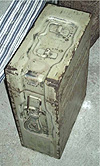 |
(Left) Figure 23: 2cm Flak 30/38 magazine container. |
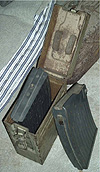 |
(Left) Figure 24: 2cm Flak 30/38 magazine container. |
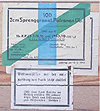 |
(Left) Figure 26: Paper label from a 2cm ammunition box. |
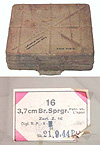 |
(Left) Figure 27: Luftdichter Patronenkasten d. 3.7cm Flak 18. Note the colour, text and paper label. It is exactly the same container type as used for the German stick hand grenade. |
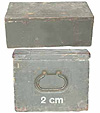 |
(Left) Figure 28: 2cm ammunition box. Note the colour and text. |
Shells/ basic body colours - all calibres:
Olive green, olive drab or field grey: High explosive
(only non anti-aircraft), anti-concrete, smoke, chemical or hollow charge
shells, and case shots.
Black: Armour piercing shot or shell.
Yellow: Anti-aircraft high explosive shell.
Red and blue: Anti-aircraft incendiary shrapnel shell.
Pale green: Star shell.
Cartridge cases/basic body colours - all calibres:
 |
(Left) Figure 32: Steel 3.7cm Flak cartridges in matt light field grey colour, the brown stuff is not rust but weapon grease. |
Brass cartridges: Brass – some brass cartridges
could also have a copper shine. 2cm–12.8cm.
Steel cartridges: Shiny greenish lacquer layer. 2cm
only.
Steel cartridges: Shiny light field grey lacquer layer.
2cm only.
Steel cartridges: Matt light field grey. 2cm–12.8cm
Steel cartridges: Shiny green. Only produced from February
1945 until end of war. 2cm–3.7cm.
Steel/brass cartridges: Steel cartridge with a very thin
brass skin covering the steel. This brass skin had a slight copper shine.
(This was an attempt to reduce the wear and tear on the gun chambers caused
by ordinary steel cartridges). 2cm–12.8cm
Fuse/basic colours - all calibres:
Nose fuse: Silver coloured Aluminium (in case of two fuse types AZ. Zt.Z. in the same shell, the other one was placed in the bottom of the shell “Bodenzünder”).
Tracer markings/ Basic colours - all calibres:
 |
(Left) Figure 33: 2cm Flak 30/38 HE shell with a red tracer. |
A 5mm-wide red, green, yellow or white band on or just above the shell's driving band on the calibres from 2cm to 4cm. The rest had a 1cm-wide band. The band reflected the shell's tracer colour. Red was the most common.
Incendiary markings/basic colours - all calibres:
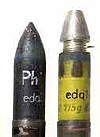 |
(Left) Figure 34: 2cm
Flak 30/38 shells. "Edq" is the manufacturer's code. In
this case Deutsche Waffen und Munitionsfabriken A.-G Lübeck-Schlutup. |
A 5mm-wide blue band just below the nose fuse and or a 12mm high white or black Ph (phosphorus) stamped on the side of shell.
Text stamped on shells and cartridge cases - all calibres:
 |
(Left) Figure 35: 10.5cm cartridges. He and AP ballistic capped. The large II, III, IV are the weight classes. KPS, FES or KES stands for the bimetallic type of driving band. |
Normal combat load for a 2cm and a 8.8cm gun in 1940
In 1940 the normal combat load of ammunition for one gun for a normal Flak Zug was:
8.8cm
200 - Sprgr. Patr. Percussion fused.
200 - Sprgr. Patr. Time fused.
100 - Pzgr. Patr.
2cm
4800 - Sprgr. Patr. Percussion fused.
200 - Sprgr. Patr. Time fused.
100 - Pzgr. Patr.
During the war this changed slightly due to shortages and new types of ammunition coming into use.
Sources:
Die Flak Stellungen ein Typen heft (1944, German handbook, WWII
origin)
Recognition handbook for German ammunition (1945, Allied forces
handbook, WWII origin)
The Luftwaffe data book (ISBN 1-85367-293-9)
German Flak in WWII (ISBN 0-7643-0399-6)
Die leichte und mittlere Flak 1906 – 1945 (ISBN 3-7909-0395-7)
FLAK im Einsatz 1939–1945 (ISBN 3-7909-0562-3)
Der geschichte der deutschen Flakartillerie 1939-1945 (ISBN 3-7909-0166-0)
Dan Mouritzsen, 2003.
| |
|
|